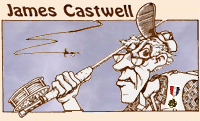|
A week ago, in Pennsylvania, it seemed every stream
I fished ran from my left to my right. Most of the
rising, or potential rising trout were on the edges,
near the shore. As I am right-handed it presented a
fine casting challenge.
The current was faster in the middle than it was at
the sides. My problem was how to present a dry fly
with about thirty feet of fly-line so it would not
drag half an instant after landing. I loved it.
Situations like this are handled automatically by guys
who have fly fished for years, but I will try to point
out some things for those a bit new to the sport.
For years I have been teaching 'loop-control' to beginners.
Not only the nice tight, wedge shaped loops, but I urged
them to practice casting the great-big, (usually worthless)
front loop, then gradually increasing the tightness of
the loop. This not only gives them a real cast to practice,
but can work well on the stream too. It's also a good idea
to practice it on the back-cast.
Most of you know of the 'reach-cast,' but I rarely see
it performed correctly. If the line is not allowed to
slide through the guides on the delivery, the distance
will be shortened on the cast. (The reach-cast is done
by aiming your cast as normal, then as the fly is on
it's way, reaching to your side with the rod as the
line falls to the water. This will put the line upstream
and allow the fly to rest a bit before it starts to drag.)
The way to get the most out of the cast though is to
have plenty of free fly line ready and allow it to
slip through the guides as you do the 'reach.' This
will not shorten the cast and will give you a longer
drag-free time before it starts to drag.
You can call it anything you like. Reach cast, slip cast,
slip reach cast, reach slip cast. Just do it, it works
better.
Now let's go a step further. Add the big loop on the
front cast to it. This will cause a whole bunch of loose
line to fall at the location of the fly and leader. Not
that hard to do, just may sound like that here. Make
the cast with the big front loop, right after you
stop the rod, reach to the side and let line slide
through your fingers, keeping your rod tip low,
follow the floating line with the tip and control
the slack in your line as it drifts past you.
If you practice it a little it will become second-nature
for you too. I will state for sure, this cast will create
'wind-knots' faster than any I know of. But you will
get hits you would not otherwise. ~ JC
|





